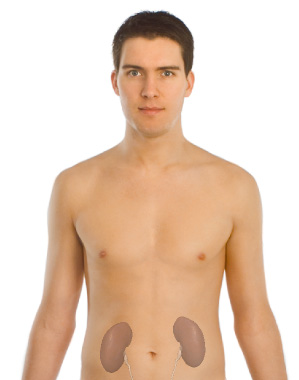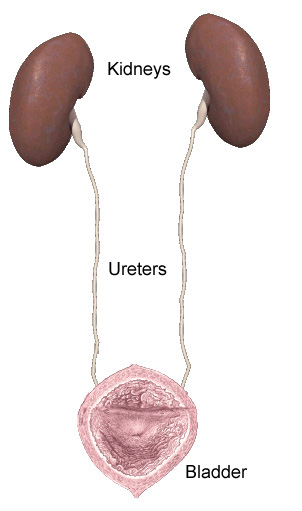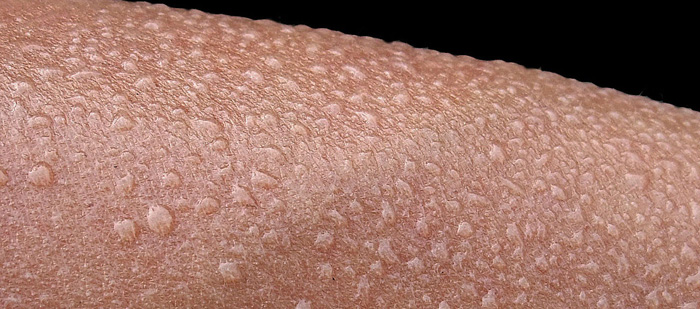Excretion - The Removal of Metabolic Waste
Kidneys - Excretion of water, urea, mineral salts,
... and all manner of other substances in low concentrations. Urea is a compound that contains nitrogen that must be removed from the body or it will build up to poisonous levels. The kidneys remove it from the blood and a whole host of other chemicals in a "don't recognise that we need it, so out it goes" sort of way.
Lungs - Excretion of carbon dioxide.
The large bag on this mans back is called a Douglas Bag. He breathes in air normally and all the exhaled air is collected in this bag which can then be analysed to determine how hard and efficiently he is working from the oxygen he uses and the carbon dioxide produced. In this case the situation being simulated is operating torpedoes on a submarine under very hot conditions.
Skin - Excretion of water, mineral salts and urea.
The purpose of sweating is to cool the body down, most of the time it happens almost imperceptibly, though at others like this, it is very obvious! The volume of sweat produced each day can be as little as 100ml or as much as 10 liters with vigorous physical activity in a hot climate and enough water intake. Though it comes out sterile, sweat contains urea and minerals that bacteria like, so if you don't clean up, the bacteria rather than the sweat itself can make your world smellier than you'd like.
Excretion is the removal of metabolic waste. In humans this mainly involves, urination, exhalation and sweating. It does not involve having a poo (actually it does a bit, but not in the way you think, more of that later). The most surprising of these for most people is that exhalation (breathing out) is excretion, you are doing it now where you are sitting or standing, though it's perhaps best not to tell anyone around you that you're excreting right now as they might be a bit upset about it without further explanation.
Imagine your body is a doughnut (easier for some than others). Your body is the mass of the doughnut and the hole through the middle is your gut. One end of the hole is your mouth, the other end is your bum. To be excretion, what is in the gut needs to leave and become part of your body, leaving the hole and become part of the doughnut that is, before it is removed. This makes it metabolic waste as it has taken part in the metabolism or the chemical workings of your body.
Anything that just stays in the hole through the middle never becomes part of the doughnut and so doesn't become a part of your metabolism. The removal of food waste that your body has processed and taken what it wants from is NOT excretion as it only ever stayed in the hole in the doughnut for the trip through. Removal of this waste is properly called defecation.
Excretory Organs
 Kidneys
Kidneys  Lungs
Lungs Skin (all of it, not just that bit)
Skin (all of it, not just that bit)
The role of urination in excretion is above all the removal of nitrogen-containing (nitrogenous) waste.
Nitrogen comes into your body as protein. You need protein every day but you can't store it for another day. The problem is that protein that is not being used will break down into ammonia NH3, a particularly potent and unpleasant poison.
This extra nitrogen needs to be removed from the body before it causes problems. What your body rather cleverly does is to take the extra nitrogen from the amino acids that make up protein and convert it into a not-so-poisonous compound called urea before it can become ammonia. This happens in the liver. The urea is then put into the blood stream and removed from the blood by the kidneys. The kidneys produce a liquid called urine containing the waste product of urea which is initially stored in the bladder until break time when it is removed from the body with some degree of relief.
Urine obviously also contains water (about 95%) and is used to control the water balance of the body as a way of getting rid of excess. Beyond this though urine contains a whole host of soluble waste products that are removed from the body especially salts of various types but also excess amounts of some kinds of non-storable vitamins and in particular stuff your body doesn't recognise. A particular property of the human kidney (and those of most other vertebrates) is that they are really good at getting rid of unexpected things. They know what you need and so anything that isn't on the guest list is removed.
Here's a scenario. Parent of Grumpy Teenager (GT) says "go and tidy your room", GT says "Yeh, ok, but I just have to watch this hilarious cat video first". This is repeated several times and being v. busy GT doesn't tidy their room. Eventually GT goes out or to school and the unfair adult goes to GT's room and gathers everything up into bin bags which are placed outside the door. GT comes home again and in horror realise that all of their treasured possessions are in the same bags as the discarded fast food wrappers, dirty cups and belly-button fluff. GT goes through the bags and rescue their treasured possessions (phew!) leaving the real waste to be discarded. This is similar to the way your kidney works. The smaller soluble parts of your blood all go into the bag to be thrown out, your body doesn't necessarily recognise everything, but it does know what it wants and so can make sure it gets these things back and reabsorbs them. The kidney works by throwing away everything and then selectively reabsorbing. It's a very active process and your kidney is one of the most energy hungry organs of your body.
The yellow colour of urine is a result of a chemical that comes from the break down of old red blood cells, this is removed by the kidneys from the blood and so is another excretory product. It is useful in that it indicates how dehydrated you are. As a rule of thumb, urine should be a pale straw colour, any darker and it indicates some degree of dehydration so you need to drink more. Paler than this is fine though means you need to go to the toilet more often (though may cause some loss of dissolved minerals). The kidneys are kept healthy when they have a regular through-flow of liquids to deal with, dehydration over a long period can result in kidney problems and is more prevalent in hot, dry countries.

Exhalation or breathing out is excretion because you are getting rid of carbon dioxide CO2
.The carbon dioxide you excrete came from the food you ate. As you are reading this, about 0.04% of inhaled breath and 4% of exhaled breath is carbon dioxide. At rest each exhalation is about half a liter or 500cm3 of air, so each breath out has around 20ml of carbon dioxide or 0.023g which contains 0.006g of carbon that entered your body in your food. Maybe that pasta you had yesterday, the cereal at breakfast or the rapidly-processed sugary drink you had a little while ago.
Picture - An alveolus in the human lung where oxygen enters the blood and carbon dioxide leaves, added together, two human lungs have about the area of a tennis court.
The food was firstly digested by being broken up into smaller (though still quite large) molecules and then absorbed into your blood stream. They were then carried to your body cells where the products of digestion, the carbon-containing high energy molecules of carbohydrate, amino acids from protein or the products of fat and oil digestion were taken in and used in the mitochondria in your body cells. The carbon atoms were joined with oxygen that came in at the lungs to release energy which helps your heart to beat, your brain to think and your arm and finger muscles to pick your nose (you don't do that? - ah, ok, sorry) amongst other things. A waste product of this process is relatively low energy molecules of carbon dioxide which are somewhat poisonous and need to be got rid of. They go via the blood stream again to the lungs where they are breathed out or excreted.

Sweating isn't really designed to remove metabolic waste as excretion, it is designed to cool you down and in the process becomes excretion because it gets rid of waste co-incidentally.
We sweat in order to cool down, the water in the sweat evaporates and takes away heat energy from your skin so cooling you down. The distribution of sweat glands on your body is not uniform and varies from about 60 to nearly 400 per square centimeter, the highest concentration is the palm of your hand and the lowest on your back and legs. The daily production of sweat varies greatly depending on the external temperature, your clothing and your level of activity. The volume of sweat produced can vary from around 100ml to over 10,000ml (10 liters) a day and can be as much as 2,000ml an hour during vigorous exercise in hot conditions. Children do not sweat as much before puberty as they do after puberty.
What makes sweating excretion is that while sweat is overwhelmingly water (99 to 99.8%), it also contains some dissolved substances as a result of it being produced from the blood plasma. Notably it contains sodium chloride (aka common salt, the reason that sweat tastes salty and why you get those white stains after it dries on clothes), potassium and urea. Sweat has some chemical similarities with diluted urine, there is about 1/20th of the concentration of urea in sweat as there is in urine. When sweat comes out from your sweat glands it is sterile and doesn't smell, but that urea and most importantly, the nitrogen it contains encourages the growth of bacteria. It is the bacteria that grow in the presence of urea that leads to the unpleasant smell of body odour. So you need to make sure you wash yourself and your clothes regularly, especially if you get hot and sweaty. This can be something of an issue for young teens who are going through puberty from a fairly unsweaty and so not so smelly child, to a potentially more odouriferous adolescent. Even though in many ways little has changed, the potential for getting a bit stinky certainly has.
| Excretory products | Excretory organ |
| Water | Kidney, skin |
| Urea | Kidney, skin |
| Minerals salts | Kidney, skin |
| Carbon dioxide | Lungs |
| Urobilin (the yellow stuff in wee) | Kidney |
| Bilirubin (the brown stuff in poo) | Liver (via gall bladder and bile duct) |
Photo credits: Sweaty arm: Minghong - Creative Commons 3.0 license; Outdoor toilet: Jorge Lascar Creative Commons 2.0 license



